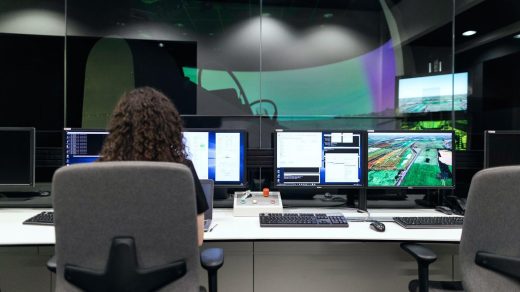The world of education is undergoing a significant transformation driven by technology integration. With the rapid advancement of digital tools and platforms, education is becoming more accessible, personalized, and efficient.
In this blog, we’ll explore how technology is shaping the future of education, and we’ll back our insights with compelling statistics highlighting the impact of these changes.
Online Learning: Is it a Global Phenomenon?
Yes, online learning has become a trending phenomenon, with the e-learning market experiencing exponential growth. The report shows that the global e-learning market was valued at $197.00 billion in 2020. This market is projected to reach $840.11 billion by the end of 2030, registering an increase of 17.5% of CAGR from 2021 to 2030.

Source: (Allied Market Research)
The COVID-19 pandemic has further accelerated this surge in online learning. A report by UNESCO shows that over 1.6 billion students and youth across 190 countries were affected by closures in 2020, forcing a swift transition to remote education. It’s clear that online learning has become a vital component of the modern educational landscape.
How Technology is Changing Learning?
From the explosive growth of online learning to the rise of adaptive learning, gamification, virtual reality, and data analytics, the education landscape is undergoing a profound revolution. Let’s explore how these innovations are shaping the future of education and paving the way for a more inclusive and effective learning system.
Blended Learning: The Best of Both Worlds
Blended learning, which simply combines traditional classroom instruction with online components, is rising. EdTechXGlobal 2021 report revealed that 97% of education executives believed blended learning was here to stay.
Learning Management Systems (LMS) have enabled blended learning. According to Statista, in the fall of 2020, more than 90% of U.S. colleges and universities reported using an LMS. These systems empower educators to deliver content, engage with students, and track their progress in an online environment.
Adaptive Learning: Personalized Education
Adaptive learning, powered by artificial intelligence, is revolutionizing how students learn. This technology tailors educational content to each student’s unique needs, enhancing the learning experience. Tyton Partners, in their survey, found that 31% of U.S. school districts were already using some form of adaptive learning technology.
The statistics speak to the effectiveness of adaptive learning platforms. For instance, Khan Academy, one of the leading platforms, boasts over 120 million registered users as of 2021. This personalized approach to education can significantly improve student outcomes.
Gamification: Learning Made Fun
Gamification is about making education engaging and enjoyable by incorporating game-like elements into the studying process. An eLearning Industry study found that 83% of learners believed that gamified content made them more productive.
Gamified learning applications have gained enormous popularity. An app like Duolingo, a language learning platform, reached over 500 million downloads in 2021. By turning education into a game, students are more motivated to participate and learn.
Virtual Reality (VR) and Augmented Reality (AR): Immersive Learning
Virtual Reality (VR) and Augmented Reality (AR) are offering immersive educational experiences that were once thought impossible. Market Research Future predicts that the global VR in education will grow at a staggering CAGR of 59.2% from 2021 to 2027.
In 2020, Google reported that over 20 million students and teachers were using Google Expeditions to explore virtual reality educational content. AR and virtual reality apps allow students to visit historical sites, conduct science experiments, and participate in interactive simulations, providing a level of engagement and understanding that traditional textbooks simply cannot match.
Artificial Intelligence (AI) in Education
Advanced technology like artificial intelligence has made significant inroads into education, transforming how students learn and teachers instruct. According to HolonIQ, global edTech venture capital investment reached $16.1 billion in 2021, with a strong focus on AI-powered edTech solutions.
AI-driven tutoring platforms are changing the way students receive help. Platforms like ScribeSense have seen a 70% increase in usage, demonstrating the demand for personalized, data-driven educational support.
Open Educational Resources (OER): Accessible and Affordable
OERs are freely accessible and customizable educational materials that are gaining traction. UNESCO estimates that OER can save students $1,000 annually on textbooks and learning materials. OER Commons, a platform hosting such resources, had over 64,000 educational resources as of 2021.
OER is making quality education more accessible and affordable to learners worldwide. This approach reduces the cost of educational resources and promotes collaboration among educators globally.
Massive Open Online Courses (MOOCs): Learning on a Global Scale
MOOCs have become a global phenomenon, offering high-quality education to a vast and diverse audience. In 2021, Coursera, one of the leading MOOC platforms, reported a staggering 76 million registered learners, highlighting the immense popularity of this online learning model.
Moreover, the impact of MOOCs extends beyond sheer enrollment numbers. In 2021, EdSurge reported that a remarkable 52% of U.S. universities were offering MOOCs. This trend underscores the recognition of MOOCs by traditional institutions as a viable mode of education delivery.
MOOCs are reshaping the educational landscape by democratizing access to knowledge. They provide learners with flexibility regarding when and where they engage with educational content, making it possible for individuals worldwide to access high-quality courses. As a testament to this accessibility, many educational providers have turned to a live-streaming video app to support their MOOC offerings.
Incorporating live-streaming apps into MOOC platforms enhances the interactive aspect of online learning. These apps enable real-time communication and engagement between instructors and students, creating a more immersive and dynamic learning environment. Students can participate in live lectures, ask questions, and collaborate with peers, mirroring the interactivity of a traditional classroom.
Blockchain in Education: Secure and Verifiable Credentials
Blockchain technology is being explored to store and verify academic credentials securely. This innovation can potentially streamline the verification process for both employers and educational institutions.
A survey by Learning House in 2018 revealed that 52% of U.S. colleges and universities were experimenting with blockchain to verify credentials. As blockchain technology matures, it has the potential to revolutionize the way we verify educational qualifications.
Internet of Things (IoT) in Education: Smart Classrooms
The Internet of Things (IoT) is transforming education by creating smart classrooms. MarketsandMarkets report projected that the global IoT in education market will reach $11.3 billion by 2023.
Internet of Things devices can be used to create smart classrooms, enabling better student attendance tracking, monitoring equipment usage, and enhancing the overall learning environment. These connected devices are creating a more interactive and data-rich educational experience.
Data Analytics: Informed Decision-Making
Data analytics is providing educators and institutions with powerful tools to make data-driven decisions. A study by EdTech Magazine found that 63% of educators believed data analytics could improve student success.
The e-learning analytics market was valued at $7.47 billion in 2020, with a projected 23.5% CAGR growth by 2028. These analytics are helping institutions track student performance, assess the effectiveness of teaching techniques, and make data-driven decisions to improve educational outcomes.
Conclusion
The future of education is becoming increasingly digital, flexible, and personalized. The statistics presented throughout this blog post illustrate the profound impact of technology on education.
From the rapid growth of online learning to the rise of adaptive learning and the use of AI in education, the transformation is undeniable. As technology evolves, educators, students, and institutions must adapt to these changes to maximize their benefits.
The key challenge lies in ensuring that technology in education benefits all students and does not exacerbate existing educational inequalities.
By addressing digital access, privacy, and data security concerns, we can build a more inclusive and effective educational system that prepares students for the challenges of the future.
The education journey has never been more exciting, and technology is paving the way for a brighter, more accessible, and equitable future of learning.
Author Bio

Gaurav Kanabar serves as the Chief Technologist for Digital Content and Platforms at Luckymatrix. Alongside his role at Luckymatrix, Gaurav is CEO of Alphanso Technology, an India-based software development company developing open-source streaming software and more for helping entrepreneurs, independent artists, and more.




Recent Comments